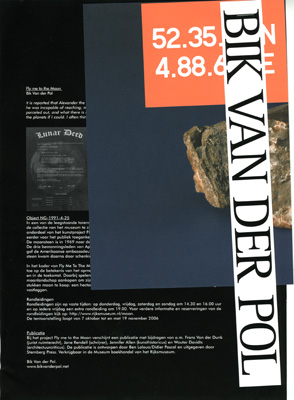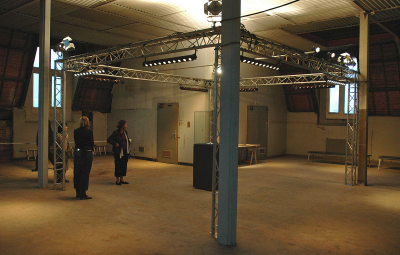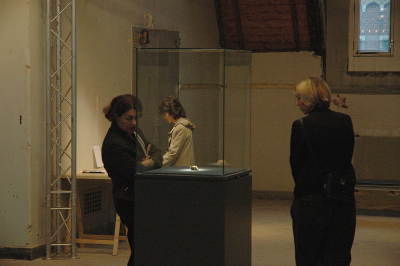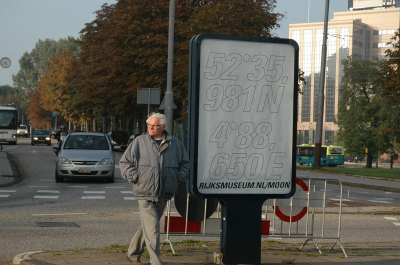
Fly Me
To The Moon
Rijksmuseum
Amsterdam
2006
Fly Me To The MoonThe core item of this project is the oldest object in the collection of the Rijksmuseum: a moon rock. The crew of the first manned lunar landing mission Apollo 11 brought this small piece of rock to earth in 1969. That same year the three astronauts Neil Armstrong, Edwin Aldrin and Michael Collins went on a world tour. They also visited the Netherlands. Willem Drees, a former Dutch prime minister, received the rock on that occasion as a present from the United States ambassador at that time. And later, this piece of stone was donated to the Rijksmuseum. The presence of this extraordinary object in this public collection not only calls out for questions that highlight issues around the location, site and history of the museum, but also, more importantly opens up to the opportunity to question, through this object, what establishes a public collection, as well as the origin and authenticity of objects in this public collection, and issues of ownership and colonialism. The project addresses these issues from various perspectives. In the background are questions concerning the public and private significance of a collection, national identity, the role and economic factor of a museum for a city and country, as well as questions around public interest, ownership and the future of collections such as this one.
'Making public' is a parameter in this project that is commissioned by the Rijksmuseum and the Rijksgebouwendienst in the context of the building being under construction for renovation.
Different levels of narrative mediation are explored and unfolding in the project; the exhibition of the moon stone in one of the highest towers of the Rijksmuseum; weekly guided tours by a guide narrating the story of the stone through a 'dynamic script', leading the public to the top floor of the empty and fully stripped tower of the museum; a series of talks with scientists and experts; the purchase of a deed of 1 acre on the moon, roughly the same size of the area of the Rijksmuseum, on the name of the museum to anticipate a possible move in the future; posters in public light boxes on busstops and along the roads of Amsterdam, designed by Ben Laloua/Didier Pascal; the publication Fly Me To The Moon, designed by Ben Laloua/Didier Pascal with texts by Jennifer Allen, Bik Van der Pol, Wouter Davidts, Frans Von der Dunk and Jane Rendell, published by Sternberg Press; and a strong communication strategy supported by ING developed in collaboration with a professional communication bureau.
Addendum: After visiting the exhibition, geologists of the Free University (VU) in Amsterdam approached the artists with the request to to study the rock. At the time, the museum rejected this request, but some years later, this request is finally granted by the new director Wim Pijbes. Very quickly the geologists discovered that the moonrock in the collection of the Rijksmuseum is actually not from the moon and this news went viral. See: moonrock search, maansteen, and The Addition. The artists donated the deeds and printed matter to the collection of the Rijksmuseum, adding new and critical layers to the collection.

 Moonrock (collection Rjksmuseum, Amsterdam)
Moonrock (collection Rjksmuseum, Amsterdam)






